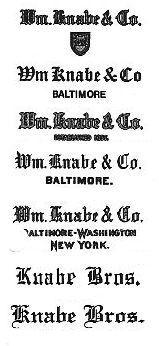Manufacturers Index
A B C D E F G H I J K L M N O P Q R S T U V W X Y Z
| Featured Pianos | Piano Company Profiles |
| Pianos We've Restored |
 WE ARE GRATEFUL TO CELEBRATE BEING IN BUSINESS DOING WHAT WE LOVE FOR 50 YEARS
WE ARE GRATEFUL TO CELEBRATE BEING IN BUSINESS DOING WHAT WE LOVE FOR 50 YEARS
— SINCE 1974 —
REGISTERED PIANO TECHNICIAN
— SINCE 1982 —
A B C D E F G H I J K L M N O P Q R S T U V W X Y Z
| Featured Pianos | Piano Company Profiles |
| Pianos We've Restored |
 History buffs and piano lovers will find in their research accounts that include the Knabe Brothers in the list of top names in American piano manufacturing, not only for good quality production standards, but for their ability to compete with some of the bigger names in the industry, like Baldwin, Weber, Mason & Hamlin, and the Steinway Company. Knabe is especially known for their outstanding concert grand pianos, many of which are still working hard today.
History buffs and piano lovers will find in their research accounts that include the Knabe Brothers in the list of top names in American piano manufacturing, not only for good quality production standards, but for their ability to compete with some of the bigger names in the industry, like Baldwin, Weber, Mason & Hamlin, and the Steinway Company. Knabe is especially known for their outstanding concert grand pianos, many of which are still working hard today.
The Knabe piano company was another American success story for piano companies. A combination of factors, including design, materials, craft work and internal organization kept the Knabe name in top standing for piano brands coming from the late 19th century. According to Loesser, there might be reason to point to certain lulls in company vision or direction, but even through times of unorganized or lapsed administrative leadership, the Knabe family name weathered its internal difficulties. It's at the turn of the century that Ernest Knabe, son of the founder, William Knabe, died, and while the company was forced to reorganize, the company had a strong reputation to help it through changing times.
Both the Knabe business and its product were held in the highest esteem, and the momentum of their achievement kept their prestige at a high level for quite a while (Loesser, 570).
Knabe concert grand pianos were in fierce competition with other major piano companies during this time. The pianos were build on a strong tradition -- since 1837 -- of piano making by William Knabe and Company. But the fame and pure excitement was to be found on the stage, and Knabe moved in this direction with full force. Contemporary hot names for the concert stage like Newell, Boscoviz, Bulow, Saint-Saens, Paderewski and many others were constantly wooed by the big piano company names. The game was to secure the piano to be played on stage by the best, brightest and biggest of names in the ever popular contemporary classical music scene. Knabe invested heavily in advertising and did manage to out bid all the other big name competitors enough times to get the Knabe piano heard by thousands of piano music lovers. With the biggest of names, Knabe was a direct and formidable competitor, and the quality of their pianos showed through the advertising blitz
Now, long after this hay day of piano manufacturing, Knabe pianos still hold their value and this is because the Knabe piano manufacturing company did produce excellent grand pianos, worthy of restoration and repair.
A piano student inherited a vintage Knabe in Baltimore, a grand piano that from a single sale as a wedding present had only been moved once and that was between rooms and floors in a large brownstone house in the same city where the piano had been built several generations before. The student had fond memories of this fine Knabe grand piano, having played it during summer visits several times growing up, but it had been years since seeing the Knabe in Baltimore.
In the interim, family life flowed into the future, the grand parents passed away and the Knabe became a memento of a fine family tradition. One day not long after the funeral, a letter arrived in the mail detailing the identifying features of the "Knabe grand piano, built in Baltimore, in the year, 1890" to be delivered by a date to be arranged in the near future. The grand parents had thought that passing the piano to their grand child would be not only an invitation to keep the Knabe in the family but a perfect gift since a strong interest in piano music had been evident since the days of summer visits.
But, as it was a gift well appreciated, it was also a gift arriving at an awkward time, as the gift's recipient was living in a rented flat across state where forth year college studies and graduation plans were currently underway.
Trying to ease tensions, and knowing that money for the piano's restoration had been set aside in the will, the executer of the estate suggested that during this last semester, rather than move the piano across state only to be faced with having to move it again after graduation, perhaps it would be a good time to have the piano restored. This way, the piano would be in the shop while new living arrangements were being made and post-graduate plans settled.
Not having seen the piano in years, the student imagined the piano through the eyes of youth and bright summer days, and like a memory of a love somehow forgotten, then suddenly recalled, the memory of that piano in prime and well maintained condition convinced the student to forgo the executer's advice. Instead of sending the piano to the shop -- rather than immediate restoration -- the student ordered a college town delivery mid-semester.
When the piano arrived, the student was surprised to see that the piano was no longer like new. The finish looked fine; grand parents had taken good care of the cabinet, but the action felt tired, sluggish with a heavy, lackluster response. The tone, too, sounded clunky and old, even after having it tuned by a local piano technician. The advice received, of course, was to invest in the pianos repair and restoration. "Like this, you have an antique that's nice to look at, the technician said, "but this piano deserves to be restored."
Having no time to face a major disappointment, it was too late to save on the impulsive move, but the student remembered the piano's former glory. There was more the piano technician said, telling the student about Knabe grand pianos, comparing the design, materials and workmanship with other piano models and company brands. "Knabe is especially known for it's exquisite concert grand pianos," said the technician, "Your piano is in that same line of fine grand piano craft work. Send it to a good repair shop and you'll be amazed at the piano you have hiding here in the dust."
So the new owner had the piano packed up again and sent to a good repair shop. Finally, the Knabe grand would receive the restorative work worthy of such a fine piano.
1954. Arthur Loesser, Men, Women and Pianos; A Social History. Dover Publications, Inc. New York.
1972. Alfred Dolge, Pianos and their Makers: A Comprehensive History of the Development of the Piano. Dover Publications, Inc., New York.
2001. Edwin M Good, Giraffes, Black Dragons and Other Pianos; A Technological History from Cristofori to the Modern Concert Grand. Stanford University Press, Stanford, California.
A B C D E F G H I J K L M N O P Q R S T U V W X Y Z
| Featured Pianos | Piano Company Profiles |
| Pianos We've Restored |